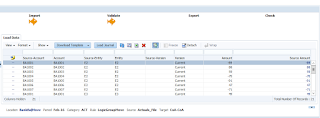In this blog, I would be talking about handling NULL fields
in FDMEE. Now, there are different ways to handle NULL fields in FDMEE. This is
one of the best things in FDMEE. You can choose an approach that is your cup of
tea or coffee.
Now, this is a snapshot of a file that was successfully
imported, mapped and pushed to an Essbase application.
Now, this is a file that we will try to load using the
existing rule file.
The first seven records have entity mapped to NULL. Note
that FDMEE makes a difference between NULL and blank space character… (More on
this later)
Below is the snapshot of the above file that was imported
and validated in FDMEE.
The problem with this is that it has rejected 7 records with
the NULL entity and I have no way of knowing this unless I am superstitious
enough to read the log file of the data load rule. There should be a way, I see
through all the data in the file that comes through and the handle the NULL
values by loading it to some specific member. For example, I would not want to
store the data at a placeholder entity and move it later to some specific
entity.
The way I am going to be doing this is by using FillL
expression that can be defined in the import format mappings. FillL basically
ensures that there is a leading fill expression so that any input value has a
minimum length. (Anyone who has worked with the outline load utility in
Planning will know the trouble you get if you have a metadata member that
begins with 0 and is a number. Excel by default will remove the 0. For example,
if I have a member 0090, then it will become 90 in excel unless formatted as
text.)
The way I will use FillL is as shown in the below snapshot.
The
import format after the mapping has been applied is as shown in the below
snapshot.
I will now reload the data as shown in the below snapshot.
If you see it now, the NULL entities have come through after the validation
against data mappings.
Since an entity with the name “00” would not be there in the
application, I create an explicit mapping to map the “00” entity to a
placeholder entity “Entity_NA” as shown in the below snapshot.
The placeholder entity in the application is as shown in the
below snapshot.
Running a revalidate and export to the application is as
shown in the below snapshot.
The data in the application as shown by a report script.
Disclaimer: The use of FillL assumes a lot of things on the
data modelling front. For example, in this demo, all the entities have a
minimum length of two. If instead of using “00”, I would have used “000” the
result would be quite different. So analysis of the data model is important
before doing NULL field handling using FillL. However, it’s a simple approach
that can be easily implemented.










Any idea how to convert a null to a zero for the amount column?
ReplyDeleteFDMEE will map NULL amount fields to zero by default...Explicit mapping not required.
DeleteThis doesn't seem to work for me if I want to apply to more than one field. The first null it reaches in a row it will work, and then that's it.
ReplyDeleteCan you send me the file format...Assuming you are loading data for multiple time periods?
DeleteYeah Thanks...Sibin...!!!
ReplyDeleteThank
ReplyDeleteHi Sibin,
ReplyDeleteI am trying to load the data file having no data in few of the data cells. Could you please suggest how to replace that data with 0?